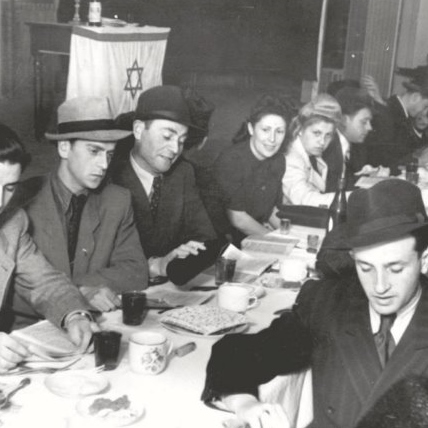
News

The history of Seders done in secret
TALI FEINBERG
“Some historians believe that Russian painter Moshe Maimon’s most famous work, Marranos: Secret Seder, actually tells the story of the Seder Hamishi, a secret Passover tradition, a special Seder, held not on the first or second night of Passover, but, as its name suggests, on the fifth night of the holiday,” writes Italy’s first female rabbi, Barbara Aiello.
After the Spanish Inquisition in 1478, Jews who had forcibly converted to Christianity continued to arouse the suspicion of Inquisition authorities – so much so that anyone who worked in households of converted Jews were offered a bounty if they could catch their employer cleaning the house of chameitz, changing pots, pans and dishes, or preparing matza.
“Then, when the first night of Passover finally arrived, Inquisition soldiers, who lay in wait for the sun to set, would burst through the doors of what had once been Jewish homes, checking to see if any of these former Jews were ‘Judaizing’ – in this case, making Passover in secret,” explains Rabbi Aiello.
“Observing this injustice, some courageous Christians concocted a plan to help their Jewish neighbours. At great personal peril to themselves and their families, these Christians encouraged their Jewish neighbours to hold a Seder, not on the first or second night, but in order not to arouse the authorities’ suspicions, on the fifth night.
“Stories are told of Christian families who allowed Jews to sneak into their Christian ‘cantinas’ (basement rooms), and under the cover of darkness, these Jews first made the space kosher and then actually observed Passover.”
Over the years, the fifth night Seder became known as the Seder Hamishi – a doubly appropriate name since ‘hamish’ is the Yiddish word for homely and friendly. The tradition of a ‘fifth night Seder’ is continued in Spain and Italy to this day.
“On this night, we also remember a fifth child,” writes Rachel Avraham on Haggadot.com. “This is the child of the Holocaust, who did not survive to ask: ‘Why was the night of Passover, 1943, different from all other Passover nights?’ And so, we ask for that child.”
She shares how, according to the testimony of Holocaust survivor Moshe Perl, a Passover Seder took place in the Vaihingen concentration camp in 1943.
Recounts Perl: “The people in the camp were already used to their miserable situation. They saw death before their eyes. But they were not willing to eat chameitz on Passover.” Yet, he asked: “Where could we get flour and potatoes and how could we bake matza?”
Perl managed to find an innovative solution: “Shortly before Passover, one of the SS men in the camp entered my workshop, where I painted signs. He asked me to make dummy targets for target practice. Just then, an idea flashed through my mind: I could suggest making big targets with wooden frames and covering them with paper bags, which were available in abundance in the camp storehouse.
“I claimed that I would need flour, lots of flour, to paste the pictures of soldiers on the targets. He asked how much flour. I said I would need 5kg. He liked my suggestion and gave me an appropriate referral.”
The Jews of the Vaihingen began baking the matza in secret, even though they knew that they would die if they were caught. Perl describes this dangerous work: “Throughout the camp, we organised wooden beams. We found a wheel among my work tools with which to roll out the dough. We baked the matza in the oven in my work room, keeping the door and windows hermetically sealed, and hid it under the shingles of our workshop roof.”
When the night of the Seder came, 20 Jews who lived in the Vaihingen concentration camp managed to pull off a Seder. Aside from the matza, they ate potatoes and drank homemade wine, which consisted of water and sugar. Although many did not survive the war, their secret Seder is preserved in Perl’s testimony.
Some families in hiding during the Holocaust made Haggadot by hand, and were even assisted by their helpers to create a Seder in secret. The Landau family lived in Borislav, Poland before the war and in 1943 a Polish woman, Anna Kushiotko, agreed to hide them.
The Kushiotko family allowed the Landaus to kasher their oven and prepare kosher matzas from grain ground in a coffee grinder. Shmaryahu Landau recited the text of the Haggadah from memory to his son Elimelekh, who wrote and decorated it. The family survived the war and the Haggadah that they made in hiding is preserved at Yad Vashem.
Under Communism, religion was banned and Jews couldn’t host Seders. “That’s why it was important to have matza,” says Slava Frumkin, who was born in the Soviet Union.
“Matza became embedded within Jewish identity,” adds Jeffrey Veidlinger, professor of Judaic studies and history at the University of Michigan, US. “In 1956, they cracked down and explicitly forbade the baking of matza inside synagogues. And there were homes that, every year, turned into makeshift bakeries around Passover.”
“In our area,” says Frumkin, “it was one home, and we would deliver the flour to the home. It was like a well-oiled machine – all the family members running and doing different things. But no matter what, in one hour you would get your matzas.




